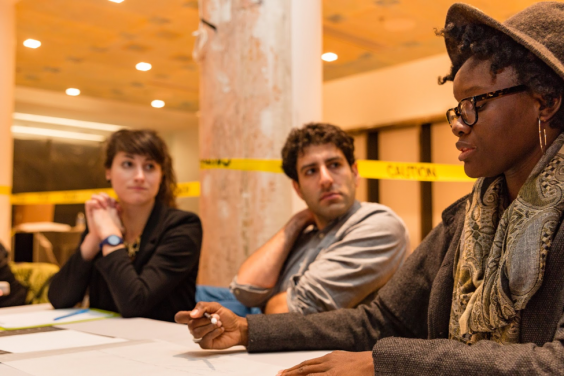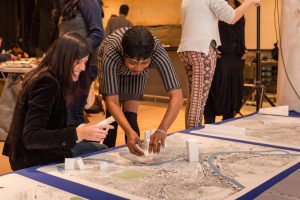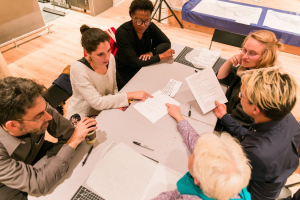Recognizing Hungers That Are Already There: A Conversation with Designer Mitch McEwen
by Leah Wulfman / January 12, 2017 / No comments
LW: Well, when Housing and Urban Development (HUD) was first started their number one list item and first priority was not helping to house people—not affordable housing—but actually active gentrification, active segregation.
MM: Gentrification is not even the right word. It’s a reverse subsidy, allocating wealth from Black America to white America. Urban planning has ways of historicizing its role in all of this. However, in architecture, if you discuss majority Black cities and neighborhoods, we don’t even have a lens to understand that we are actually talking about a public that’s already constituted. Within architecture, it’s already assumed to be so white that it is as if now we are talking in the realm of abstraction. So, even when it comes to “This is What We Will Build When We Get Our Reparations,” it is as if there is no constituted “We,” and we are already talking about “They.” So, in that situation, I needed to come up with a means of organizing the “We” in order to avoid the “They.”
LW: There’s this implication that when you are working in the realm of art and architecture in locations like Detroit, that gentrification is not so far behind. So, it is necessary to locate and contest what allows that cause-and-effect to be. How do we as architects promote improvement without displacement, true self-sufficiency and solidarity with and within communities?
MM: In Detroit, I recently started working with young real estate developers who are trying to change the model of real estate, so that as Detroit changes, people can stay in their houses as shared equity owners. Detroit is going to change.
I shy away from saying I work in social justice because we have words like gentrification that are overused. If you are only working for white people with money in a place like Detroit, then it is the case that gentrification is not far behind. This gets back to the “We” and the “They” type of dichotomy. Obviously urban planning in America is a whole different discipline unto itself, but in architecture, we have two distinct modes of working. We work with clients that we are competing for and marketing ourselves to, and then we work speculatively. While complicated, there are a number of ways to work on the marketing side with clients and not support the cultural hegemony and status quo. However, when we work speculatively, why would we ever assume that we are serving the status quo? In architecture, we have so much methodology for speculative work.
Detroit is a majority Black city, but there are no Black architecture critics.
So, we can sit here and critique something like gentrification—which, especially with its implication of the term gentry, is ultimately not that productive of a word—but on a fundamental level, why aren’t we working speculatively to design how housing could be self-sustaining as cities are transforming in the midst of climate change and everything else? Why aren’t we working speculatively on that something else? This gets back to how the lexicon in the cultural imaginary is so tainted, stifled, and pathologized. We can’t even think speculatively.
LW: This gets to the disparity that arose at this past year’s Venice Architecture Biennale, “The Architectural Imagination,” which A(n) Office took part in. The American Pavilion was an exhibition of new speculative architectural projects designed for specific sites in Detroit. I remember there being a response by some city inhabitants and grassroots organizations suggesting that maybe what should be considered and worked upon more genuinely are actual “Community” and “Activism” in the architectural imagination. So, part of the discussion was in regards to how we expand our notion of who has imagination as well as how community activism operates and whom it is for. How can the architectural imagination be broadly encouraged and not just privileged in architecture?
MM: This was Detroit Resists‘ position, and they held that position before any work was even completed. I thought the conversation around this was utterly stupid. Their issues with the curators became this whole polemic that was never adjusted or investigated after the work was produced. My real issue was that it was merely this reductive polemic that got picked up by nearly every single architecture critic. It became this super easy, redundant critique.
I mean, how many Black architecture critics can you name? We can’t name any Black architecture critics. Detroit is a majority Black city, but there are no Black architecture critics. So, critics are wondering how they can step into this conversation, while protecting themselves from potential criticism due to failing to see one aspect or another. There was so much reification of self that was then packaged into the criticism.
This is again part of the larger pathology, where if you suggest that somebody is racist, then you are assumed to be assaulting and offending them. When in actuality, you are providing a useful critique, some feedback on what somebody might want to work on. So the architecture critical response basically was, “I am going to protect myself from a kind of failure of identification; I’m not going to do any research into Detroit; and I’m not going to talk to any of the activist groups on the ground.” There are activist groups in Detroit that have been around for decades working on different aspects of city planning, housing, food, urban farming, all of this. So, the architecture critics rather than doing any research, rather than exposing their fragility and working on it, they took Detroit Resists’ response as a carte blanche for every single article that they wrote. They didn’t have to read any of the projects. So, it became the laziest architecture criticism, and, not all, but much of it became completely insulting to Detroit. Some of it became exceptionally racist.
Detroit Resists’ position was problematic to begin with because the pretense was that an aesthetic imagination in architecture and architectural production is already foreign to residents of Detroit and to Black America, and that therefore, this aesthetic imagination has to be an imposition. Excuse me, Black America had to be so amazingly imaginative and culturally productive in order to survive in this country. Black America re-invented nearly every musical form, every performative and poetic form, and you are going to say that they can’t participate in the architectural imagination? That is ridiculous.
So, when this all was picked up by architecture critics—in addition to being a terrible representation of the architecture projects—the criticism became active erasure, stupidly ignorant and racist. There was so much in the projects, and this was such a missed opportunity. Andrew Zago’s project, regarding Syrian refugees, took an international question and compacted it into Detroit. On a local level, his project was incredibly relevant in part because of the high density of Arab Americans in the Detroit area. Andrew Zago combined imaginative thinking and formal strategies with research into how development in Detroit can function at multiple scales.
Then there was Marshall Brown with his education tower the Dequindre Civic Academy (DCA), which was a critique of how development needs to be combined with other forms of public infrastructure—not just physical infrastructure but also knowledge-based. This relates to what people say in Detroit all the time; the City isn’t going to “come back” until the schools are fixed. There are certain ways that this is reduced in the local discourse, but everyone knows that the schools have been purposefully destroyed by the state of Michigan. These strategies have now been going national with the craziness of the recent election. People ought to be paying attention to the thoughts and the work that are in those architectural projects, but instead the architecture criticism in this country maintains the status quo.
Continue reading this article on page 3







